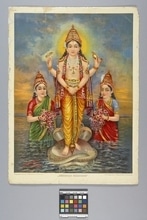Item number Cg66 from the MOA: University of British Columbia.
 Public
Public
Item Records
This page shows all the information we have about this item. Both the institution that physically holds this item, and RRN members have contributed the knowledge on this page. You’re looking at the item record provided by the holding institution. If you scroll further down the page, you’ll see the information from RRN members, and can share your own knowledge too.
The RRN processes the information it receives from each institution to make it more readable and easier to search. If you’re doing in-depth research on this item, be sure to take a look at the Data Source tab to see the information exactly as it was provided by the institution.
These records are easy to share because each has a unique web address. You can copy and paste the location from your browser’s address bar into an email, word document, or chat message to share this item with others.
- Data
- Data Source
This information was automatically generated from data provided by MOA: University of British Columbia. It has been standardized to aid in finding and grouping information within the RRN. Accuracy and meaning should be verified from the Data Source tab.
Description
Rectangular calendar print depicting Vishnu, a four-armed male adorned with necklaces, bracelets, earrings, armlets and in a gold crown with yellow sunburst halo shape behind. He is wearing yellow and orange dhoti; floor-length from waist. He stands on top of rounded globe with cobras coiled around circumference. All float in blue green lake. Vishnu is flanked by two women wadding in the water; one in a green sari, the other red. Each holds a pink, red and green flower bouquet. Mottled blue and orange sky background. 'Printed in Germany', 'Sreeman Narayana' and 'Coconada 1928' written on print.
History Of Use
Indian popular religious prints have been published for nearly a century, first by German presses, later by Indian ones. The prints may take the form of calendars, posters, or simply images. The style of the representations is European. In the beginning they were Hindu images, but are now acquiring elements both of folk art and a romantic secularism. It is a living art currently influenced by the movie industry and non-Hindu religions. The images are a vehicle for advertising and are also used for religious purposes. This image was printed in Germany for the South Indian market, then framed and displayed in a prayer room for 'puja' or worship.
Narrative
From collection of calendar prints collected in southern India.
Iconographic Meaning
Vishnu, preserver of the universal order, establishes law and order and protects the world from evil and destruction through ten earthly incarnations. He is identified by: rotating discus; six-petaled lotus; mace symbolizing his power of knowledge; white conch shell; gold crown; and his flying mount, Garuda.
Cultural Context
popular religious art
Item History
- Made by N. Gopala Row (Maker) in Germany during 1928
- Collected between 1974 and 1982
- Owned by Stephen Inglis before January 1983
- Received from Stephen Inglis (Donor) during January 1983
What
- Name
- Identification Number
- Cg66
- Type of Item
- Overall
- height 51.3 cm, width 37.7 cm
Where
- Holding Institution
- MOA: University of British Columbia
- Made in
- Germany
Who
- Culture
- South India
- Creator
- N. Gopala Row (Maker)
- Previous Owner
- Stephen Inglis
- Received from
- Stephen Inglis (Donor)
When
- Creation Date
- during 1928
- Collection Date
- between 1974 and 1982
- Ownership Date
- before January 1983
- Acquisition Date
- during January 1983
Other
- Item Classes
- works on paper
- Condition
- poor
- Accession Number
- 0857/0117
Ask a question
Let the RRN community answer your questions
 Public
Public
With an account, you can ask other users a question about this item. Request an Account
Shared Knowledge
Share your knowlege of this item with the RRN community
 Public
Public
With an account, you can submit information about this item and have it visible to all users and institutions on the RRN. Request an Account









